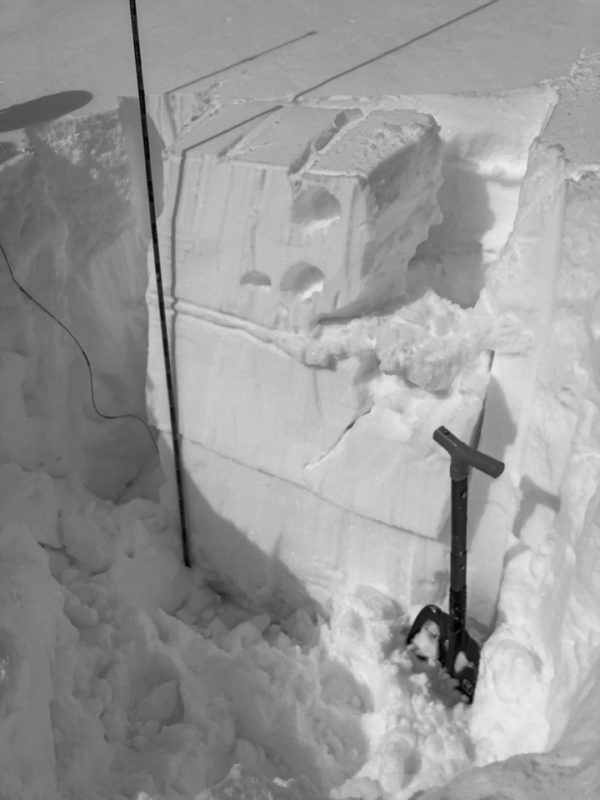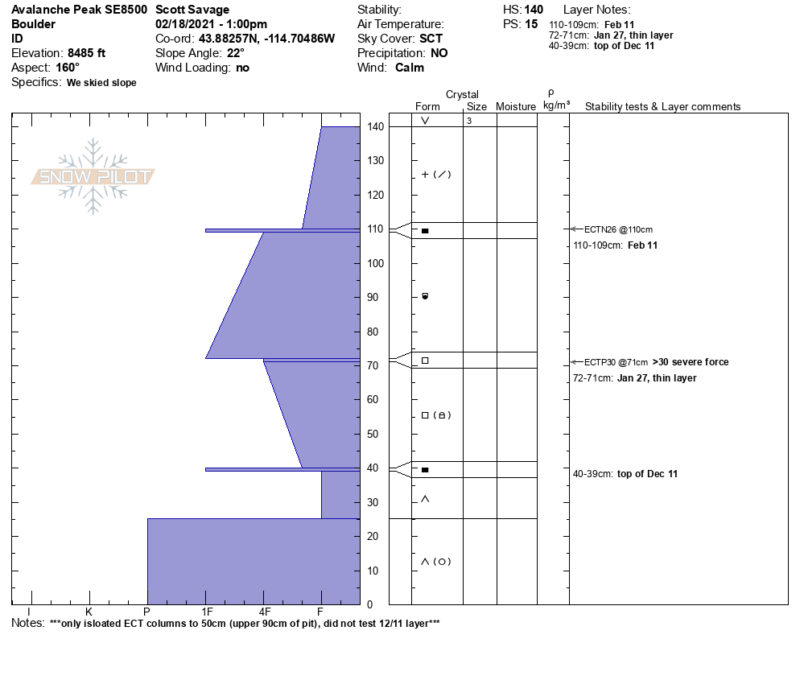Basic Information
Observation Details
Observation Date:
February 18, 2021Submitted:
February 18, 2021Observer:
SAC - Davis, SavageZone or Region:
Galena Summit and Eastern MtnsLocation:
Avalanche Peak (WRV and Smiley Ck Sides) (All aspects, 7,700-9,400')Signs of Unstable Snow
Recent Avalanches?
YesCracking?
None ExperiencedCollapsing?
IsolatedSnow Stability
Stability Rating:
GoodConfidence in Rating:
ModerateStability Trend:
SteadyBottom Line
Poor snowpack structure exists in thinner, rockier, and more wind-exposed areas around Avalanche Peak. Despite today's unremarkable snowpack test scores, these areas would not respond well to a rapid load.
Media/Attachments




Advanced Information
Weather Summary
Cloud Cover:
OvercastTemperature:
Low 20sWind:
CalmNew/Recent Snowfall:
30 cm settled storm snow since 2/11High clouds moved in mid-morning and clouds thickened to proper overcast by about 1130 AM. The wind was calm where we were and no sign of wind moving snow on nearby peaks. No new snow had fallen as of 430 PM.
Avalanche Observations
| # | Date | Location | Size | Type | Bed Sfc | Depth | Trigger | Photos | Details |
|---|---|---|---|---|---|---|---|---|---|
| 3 |
Feb 15, 2021 (+/- 3 days) |
Smiley Ck N 9800ft |
D2 | N-Natural | Report | ||||
| 1 |
Feb 16, 2021 (+/- 1 day) |
Abe's Armchair - Smiley Ck E 9000ft |
D1.5 | SS-Soft Slab | N-Natural |

|
Report |
We had good visibility into the southern Sawtooths from about Mattingly Pk to Decker Pk and did not observe much more than a handful of smaller sluffs and slabs.
Snowpack Observations
Total snow depths in sheltered areas were between 100-130 cm.
Avalanche Peak WRV, SE, 8,500':
The new/old (2/11) interface was down ~30 cm, presenting as a 1 cm melt-freeze crust on sunnier slopes. This layer doesn't strike me as one that will last long. ECTN26. The (1/27) interface was down ~70 cm and presented as a layer of facets. We did get an ECT to propagate after applying non-standard force. ECTP>30. (See profile).
Avalanche Peak Smiley Ck, SE, 9,050':
We sought to find these same PWLs in thinner, rockier terrain. The snow depths and stratigraphy changed quickly in the thinner, more heavily wind-affected areas so a "representative" slope isn't realistic. Generally speaking, we found a snowpack where snow since 2/11 makes up about a third to half of the snowpack. Beneath it was a stack of facets, similar to what I found on Galena Peak yesterday. I'd expect areas like these to react poorly to rapid loading. Test results were ECTNs. This is where our small collapses occurred.


Avalanche Problems
| Problem | Location | Distribution | Sensitivity | Size | Comments |
|---|---|---|---|---|---|
 Persistent Slab
Persistent Slab
|
|
Weak Layer(s):
Dec 11, 2020 (FCsf)
Comments: This layer remains the most obvious, widespread weak layer to keep an eye on with additional loading. 1/27 looked worse in our shallow pit where the interface was more heavily faceted. |
Terrain Use
We avoided skiing in or directly beneath consequential avalanche terrain.
